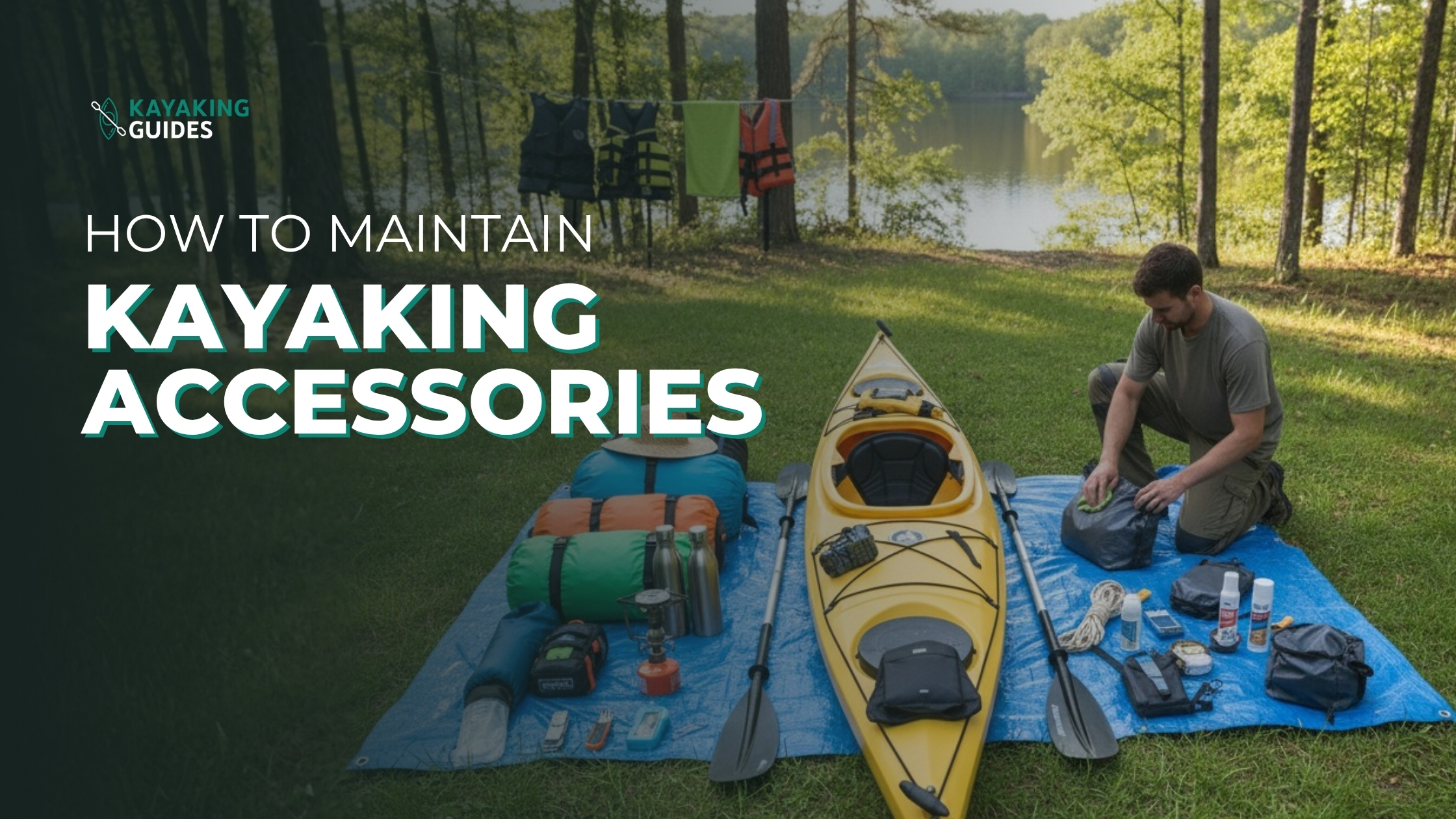Introduction
Kayaking is an exciting water sport that brings you closer to nature while offering an enjoyable physical workout. Whether you’re a beginner or an experienced paddler, having the right accessories is essential for both safety and performance. However, these accessories — like paddles, life jackets, spray skirts, and dry bags — can easily wear out if not maintained properly. Regular care not only extends their lifespan but also ensures that your kayaking trips remain safe and hassle-free.
In this article, we’ll walk you through practical and easy-to-follow steps on how to maintain your kayaking accessories.
1. Keep Your Accessories Clean After Every Use
The first and most important rule of maintenance is regular cleaning. After each kayaking trip, rinse your accessories thoroughly to remove saltwater, sand, or mud. Items such as paddles, life jackets, and spray skirts come into constant contact with water, which means they can easily collect grime and salt deposits.
Use fresh water and a mild soap to clean your gear. Avoid using harsh chemicals, as they can damage the materials and weaken stitching or coating. Once cleaned, make sure you wipe them with a soft cloth or let them air dry completely before storage. Proper cleaning helps prevent corrosion and mold buildup, ensuring your gear remains fresh for your next adventure.
2. Dry Everything Properly Before Storage
Moisture is the biggest enemy of kayaking accessories. Storing your gear while it’s still wet can lead to mold, mildew, and unpleasant odors. After cleaning, hang your accessories in a shaded and well-ventilated area. Avoid direct sunlight, as UV rays can weaken fabrics and plastic materials over time.
If you’re drying smaller items like gloves or spray skirts, pat them dry with a towel first. For bulkier gear, like life jackets, hang them to air dry completely. Remember — proper drying not only protects your gear but also keeps it smelling clean and ready to use.
3. Inspect Your Gear Regularly
Frequent inspection is key to maintaining safe and reliable kayaking accessories. Before and after every trip, take a few minutes to check your equipment. Look for signs of wear and tear, including frayed straps, loose stitching, or cracks. Pay close attention to your life jacket’s buckles and zippers, as well as your paddle blades and shafts.
Small issues can become serious if ignored. A cracked paddle or weakened spray skirt seam could cause trouble while kayaking. Regular inspection allows you to fix small damages early, saving you from expensive replacements later.
4. Repair Minor Damages Immediately
Even the best equipment can suffer from minor wear and tear. Fortunately, small tears or holes can usually be fixed with a repair kit. Most kayaking accessories come with repair materials — if not, you can easily find one at outdoor gear stores.
Follow the repair kit instructions carefully and make sure the surface is clean and dry before patching. For larger tears or equipment damage, it’s best to consult a professional repair service. Quick fixes can extend the life of your accessories and save you money in the long run.
5. Store Accessories in a Cool, Dry Place
Storage plays a big role in maintaining the quality of your kayaking gear. Always store your accessories in a cool, dry location away from direct sunlight. UV rays can fade colors and weaken materials, while damp environments can promote mold growth.
If possible, hang your life jackets and paddles vertically to avoid bending or warping. Use a gear bag or rack designed for kayaking equipment to keep everything organized. Proper storage not only helps your gear last longer but also makes it easier to prepare for your next trip.
6. Maintain Your Kayak Paddle
Your paddle is one of the most vital tools in kayaking, and it deserves special care. After each use, rinse it thoroughly with fresh water to remove sand, salt, or algae. Dry it completely and inspect it for cracks, dents, or loose connections.
Check the blade edges and the ferrule (the part that connects the paddle halves) to make sure everything is tight and smooth. If your paddle has adjustable angles, apply a light lubricant to prevent corrosion. By keeping your paddle in top shape, you’ll ensure efficient strokes and better performance on the water.
7. Take Care of Your Life Jacket
A life jacket (PFD) is essential for safety, so keeping it in excellent condition is non-negotiable. After each kayaking session, rinse it with clean water and let it air dry completely. Never use bleach or detergent, as they can weaken the foam and fabric.
Inspect the straps, buckles, and zippers regularly to ensure everything functions properly. If you notice any fraying or loss of buoyancy, it’s time to replace the jacket. A well-maintained life jacket can literally save your life, so treat it as a priority.
8. Care for Your Spray Skirt
The spray skirt keeps water out of your kayak, making it an essential accessory for comfort and performance. After use, rinse it thoroughly and check the seams and elastic edges for signs of wear. Make sure it fits snugly around your cockpit — a loose skirt won’t keep water out effectively.
Let it dry naturally in a shaded place and avoid folding it while still wet. Regular inspection and cleaning will ensure your spray skirt continues to protect you from splashes and waves.
9. Look After Your Dry Bag
A dry bag keeps your essentials safe and dry — things like phones, snacks, or first-aid kits. To maintain it, rinse it with clean water after every trip and let it air dry inside out. Check the zippers, buckles, and seams for leaks or cracks.
If your dry bag starts losing its waterproof ability, apply a waterproofing spray or consider replacing it. Proper care ensures that your valuables stay dry no matter how rough the water gets.
10. Don’t Forget the Kayak Itself
Your kayak is your main piece of equipment and deserves regular maintenance too. Rinse it after every use to remove dirt and salt. Check the hull for scratches or dents, and repair them with a marine-grade sealant if necessary.
Inspect screws, bolts, and fittings to make sure they are tight. If your kayak has a rudder or skeg system, check that it moves freely and isn’t jammed by sand. Store your kayak on padded racks or upside down to avoid pressure dents.
Taking care of your kayak ensures it remains stable, efficient, and safe on the water.
11. Seasonal Maintenance Tips
If you’re storing your gear for the off-season, take some extra precautions. Clean everything thoroughly, make sure it’s completely dry, and store it in a temperature-controlled environment if possible. Avoid basements or sheds with high humidity.
You can also apply UV protectant sprays to plastic and rubber items for extra protection against sun damage. When the next kayaking season arrives, inspect everything again before your first trip — it’s the best way to avoid surprises.
Conclusion
Proper maintenance of your kayaking accessories is key to their longevity, safety, and performance. Regular cleaning, drying, inspection, and proper storage will save you money and prevent unnecessary wear.
By giving your paddles, life jackets, spray skirts, and dry bags the care they deserve, you’ll enjoy smooth and worry-free kayaking adventures for years to come.
A little effort after each trip goes a long way — so make maintenance a part of your kayaking routine. With well-kept accessories, every paddle stroke becomes more enjoyable, and every trip more memorable.
Want more kayaking tips? Check out our guide: How to Choose Durable Kayaking Gear










